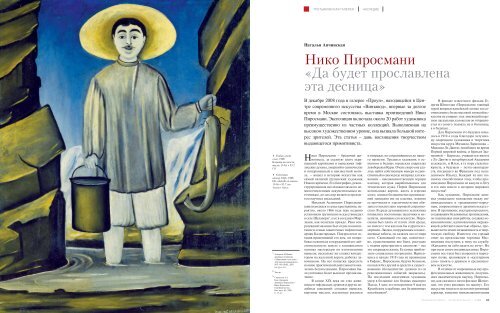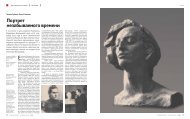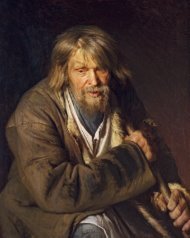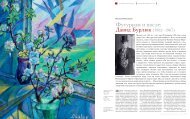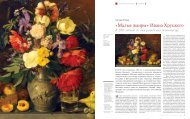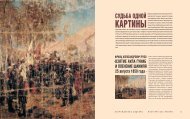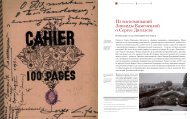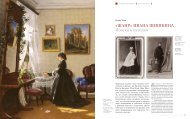Ðико ÐиÑоÑмани «Ðа бÑÐ´ÐµÑ Ð¿ÑоÑлавлена ÑÑа деÑниÑа» - ÐÑÑнал ...
Ðико ÐиÑоÑмани «Ðа бÑÐ´ÐµÑ Ð¿ÑоÑлавлена ÑÑа деÑниÑа» - ÐÑÑнал ...
Ðико ÐиÑоÑмани «Ðа бÑÐ´ÐµÑ Ð¿ÑоÑлавлена ÑÑа деÑниÑа» - ÐÑÑнал ...
Create successful ePaper yourself
Turn your PDF publications into a flip-book with our unique Google optimized e-Paper software.
ТРЕТЬЯКОВСКАЯ ГАЛЕРЕЯ<br />
НАСЛЕДИЕ<br />
Наталья Апчинская<br />
Нико Пиросмани<br />
«Да будет прославлена<br />
эта десница»<br />
Рыбак среди<br />
скал. 1906<br />
Клеенка на холсте,<br />
масло. 114,6 × 93,7<br />
ГТГ<br />
Fisherman<br />
among Cliffs. 1906<br />
Oil, oilcloth on canvas<br />
114.6 × 93.7 cm<br />
Tretyakov Gallery<br />
1 Хомерики М. Новые<br />
архивные материалы<br />
о Пиросмани и его семье /<br />
«Грузинский университет».<br />
№ 5 (49). Нояб., 2003<br />
(на груз. яз.).<br />
2 Там же.<br />
3 Стригалев А.А.<br />
Как открывали<br />
живопись Пиросмани //<br />
Нико Пиросмани.<br />
Семейный кутеж :<br />
Kат. выст. М., 2008.<br />
С. 17–41.<br />
В декабре 2008 года в галерее «Проун», находящейся в Центре<br />
современного искусства «Винзавод», впервые за долгое<br />
время в Москве состоялась выставка произведений Нико<br />
Пиросмани. Экспозиция включала около 20 работ художника<br />
преимущественно из частных коллекций. Выполненная на<br />
высоком художественном уровне, она вызвала большой интерес<br />
зрителей. Эта статья – дань восхищения творчеством<br />
выдающегося примитивиста.<br />
Нико Пиросмани – бродячий живописец,<br />
за скудную плату украшавший<br />
картинами и вывесками тифлисские<br />
духаны, умерший в одиночестве<br />
и похороненный в неизвестной могиле,<br />
– вошел в историю искусства как<br />
самый великий грузинский художник<br />
Нового времени. Его биография, реконструированная<br />
исследователями по немногочисленным<br />
документальным источникам,<br />
до сих пор является предметом<br />
научных изысканий.<br />
Николай Асланович Пиросманашвили<br />
родился в семье крестьянина, вероятно,<br />
около 1866 года (как недавно<br />
установили грузинские искусствоведы)<br />
в селе Шулавери 1 , a не в соседнем Мирзаани,<br />
как полагали прежде. Рано осиротевший<br />
мальчик был отдан на воспитание<br />
в семью зажиточных тифлисских<br />
армян Калантаровых. Повзрослев и оставив<br />
приютивший его дом, он попробовал<br />
освоиться в окружавшей его действительности:<br />
вместе с компаньоном<br />
основал мастерскую по изготовлению<br />
вывесок; несколько лет служил кондуктором<br />
на железной дороге; работал лавочником.<br />
Но все попытки преуспеть<br />
на ниве практической деятельности оказались<br />
безуспешными. Пиросмани было<br />
уготовано более высокое предназначение.<br />
В конце ХIХ века он стал живописцем<br />
тифлисских духанов и других подобных<br />
заведений: создавал вывески,<br />
картины маслом, настенные росписи<br />
и витражи, не сохранившиеся до нашего<br />
времени. Трудился художник в основном<br />
в бедных городских кварталах<br />
левобережья Куры. Очень скоро ему удалось<br />
найти собственную манеру и единственный<br />
в своем роде материал для живописи<br />
– высококачественную черную<br />
клеенку, которая вырабатывалась для<br />
технических нужд. Порой Пиросмани<br />
использовал картон, жесть и изредка<br />
холст, однако большинство произведений<br />
написано им на клеенке, именно<br />
ее прочности и эластичности они обязаны<br />
относительно хорошей сохранностью.<br />
В среде духанщиков у художника<br />
появились постоянные заказчики и меценаты,<br />
ценившие его искусство. Пиросмани<br />
был плоть от плоти этой среды,<br />
но вместе с тем жил как бы в другом измерении.<br />
Людям, погруженным в повседневные<br />
заботы, он казался «не от мира<br />
сего». Сжигавший его дар, одиночество,<br />
существование вне быта, растущее<br />
с годами пристрастие к алкоголю – все<br />
это сокращало жизнь. Ее конец приблизили<br />
социальные потрясения. Вернувшись<br />
в начале 1918 года из провинции<br />
в Тифлис, Пиросмани, будучи больным,<br />
оказался без друзей и средств к существованию<br />
(большинство духанов из-за<br />
революционных событий закрылось).<br />
По последним сведениями художник<br />
умер в больнице для бедных накануне<br />
Пасхи, 4 мая; его похоронили 9 мая на<br />
Кукийском кладбище для безымянных<br />
покойников 2 .<br />
В финале известного фильма Георгия<br />
Шенгелаи «Пиросмани» главный<br />
герой вопреки житейской логике и в соответствии<br />
с более высокой логикой искусства<br />
не умирает: под ликующий перезвон<br />
пасхальных колоколов он отправляется<br />
из своего подвала не в больницу,<br />
а в будущее…<br />
Для Пиросмани это будущее началось<br />
в 1910-е годы благодаря энтузиазму<br />
одаренного художника и теоретика<br />
искусства круга Михаила Ларионова –<br />
Михаила Ле-Дантю, погибшего во время<br />
Первой мировой войны, и братьев Зданевичей<br />
– Кирилла, учившегося вместе<br />
с Ле-Дантю в петербургской Академии<br />
художеств, и Ильи, в ту пору студентаюриста,<br />
в будущем – поэта-авангардиста,<br />
писавшего во Франции под псевдонимом<br />
Ильязд. Каждый из них посвоему<br />
способствовал тому, чтобы произведения<br />
Пиросмани не канули в Лету<br />
и его имя вошло в историю мирового<br />
искусства 3 .<br />
Как художник, Пиросмани занимал<br />
уникальное положение между индивидуальным<br />
и традиционно-народным,<br />
современным и древним искусством.<br />
В противовес мастерам прошлого,<br />
создававшим безымянные произведения,<br />
он подписывал свои работы, создавал неканонические,<br />
вдохновленные окружающей<br />
действительностью образы, превыше<br />
всего ценил независимость и творческую<br />
свободу. Известен его гордый<br />
ответ на предложение торговца Месхишвили<br />
поступить к нему на службу:<br />
«Кандалов на себя надеть не хочу». Но<br />
при всем своем индивидуализме Пиросмани<br />
все-таки был укоренен в народную<br />
почву, хранившую в «культурном<br />
слое» память о древнем и средневековом<br />
искусстве.<br />
В отличие от современных ему профессиональных<br />
живописцев, получивших<br />
академическую выучку, Пиросмани,<br />
как сказано о нем в фильме Шенгелаи,<br />
«не умел рисовать по закону». Его<br />
искусство носило в целом интуитивный<br />
характер, и именно гениальная интуиция<br />
ТРЕТЬЯКОВСКАЯ ГАЛЕРЕЯ / THE TRETYAKOV GALLERY / #1’2009<br />
45
THE TRETYAKOV GALLERY<br />
HERITAGE<br />
HERITAGE<br />
Natalya Apchinskaya<br />
Niko Pirosmani<br />
“Glory to this right hand”<br />
Женщина<br />
с кружкой пива<br />
Клеенка, масло<br />
114 × 90<br />
Музей искусств Грузии,<br />
Тбилиси<br />
Woman with a Mug<br />
of Beer<br />
Oil on oilcloth<br />
114 × 90 cm<br />
Museum of Fine Arts,<br />
Tbilisi<br />
1 Khomeriki, M. New archival<br />
materials about Pirosmani<br />
and his family / Georgian<br />
University. No. 5(49).<br />
November, 2003.<br />
(In Georgian.)<br />
In December 2008 the Proun Gallery, at the Vinzavod Contemporary<br />
Art Centre, held a Pirosmani retrospective exhibition,<br />
the first show of the artistʼs work in Moscow for many years.<br />
Impeccably designed and staged, it featured 20 works by Pirosmani,<br />
mainly from private collections, along with supporting<br />
photographic and other visual materials. It proved a huge success<br />
with the public, which was ready to queue for some time<br />
to see it. This article is a tribute to the art of the outstanding<br />
Primitivist painter.<br />
Niko Pirosmani – a vagrant artist who<br />
made pictures and sign-boards for<br />
Tiflis (Tbilisi) taverns for trifling remuneration,<br />
died forgotten by all in a hospital for<br />
the poor in 1918, and was buried in an<br />
unknown location; however he has<br />
remained in art history as the greatest<br />
Georgian artist of the modern age. His<br />
biography, pieced together from scarce surviving<br />
documentary evidence, today continues<br />
to be the focus of academic research.<br />
Nikolai Aslanovich Pirosmanashvili<br />
was born to a peasant family probably<br />
around 1866 (as Georgian art scholars<br />
recently found out) in the village of<br />
Shulaveri 1 – not in the neighboring Mirzaani<br />
village as was previously assumed. His<br />
parents died soon after his birth, and the<br />
boy was raised by the Kalantarovs, a<br />
wealthy Armenian family in Tiflis. When<br />
Niko grew up and left his guardians’<br />
home, he tried to find his bearings in the<br />
practical world: together with a partner he<br />
set up a workshop making sign-boards. For<br />
several years he worked as a railway brakeman;<br />
he also kept a small store. But all his<br />
attempts to secure a steady income<br />
through a practical occupation failed. A<br />
loftier fate was in store for him.<br />
In the late 19th century he worked as a<br />
painter in taverns and other similar establishments<br />
in Tiflis, creating sign-boards, oil<br />
paintings, murals and glass paintings, which<br />
did not survive. The artist mostly worked in<br />
poor Tiflis neighborhoods on the left bank<br />
of the Kura River. Very soon he developed<br />
an individual style and contrived to use a<br />
material unheard-of among painters – high<br />
quality black oilcloth produced for industrial<br />
needs. Sometimes Pirosmani painted on<br />
pieces of cardboard, tin plates and, occasionally,<br />
canvas, although most often he<br />
used oilcloth, the durability and elasticity of<br />
which helped the pictures to survive in a relatively<br />
good condition.<br />
Some of the tavern keepers appreciated<br />
Pirosmani’s art, commissioning work<br />
from him. While closely tied with this<br />
milieu, the artist nevertheless seemed to<br />
inhabit a different world. People entangled<br />
in day-to-day difficulties thought of him as<br />
a man “not of this world”. The talent that<br />
scorched him inside, his loneliness, existence<br />
outside a daily routine, and his drinking<br />
habit that grew over the years – all this<br />
was sapping the life out of him. His demise<br />
was precipitated by social cataclysms.<br />
Returning to Tiflis from the provinces in<br />
early 1918, a sick Pirosmani found himself<br />
without friends and means of subsistence<br />
(most taverns were closed because of the<br />
turmoil). It is now believed that the artist<br />
died in a hospital on the eve of the Easter on<br />
May 4; he was buried on May 9 at the Kukiiskoe<br />
cemetery for unidentified bodies 2 .<br />
At the end of Georgy Shengelaya’s<br />
famous film “Pirosmani” the key character,<br />
defying worldly logic and in accordance<br />
with a more sublime logic of art, does not<br />
die; instead, to the accompaniment of the<br />
cheerful Easter peal of church bells, he<br />
moves, not to a hospital, but into the<br />
future…<br />
For Pirosmani that future began in the<br />
1910s, thanks to the enthusiastic support of<br />
Mikhail Le Dantyu (who was killed in the<br />
first World War), a talented artist and art<br />
theoretician close to Mikhail Larionov, and<br />
the Zdanevich brothers – Kirill, who studied<br />
with Le Dantyu at the St. Petersburg<br />
Academy of Fine Arts, and Ilya, who was<br />
then a law student and later became an<br />
avant-garde poet living in France and writing<br />
under the pen name “Iliazd”. Each of<br />
these people contributed to the efforts to<br />
preserve Pirosmani’s art for posterity and to<br />
secure for him a place in the history of<br />
world art 3 .<br />
Семейная<br />
компания. 1909<br />
Клеенка на холсте,<br />
масло. 116 × 170<br />
ГТГ<br />
A Family<br />
Get-together. 1909<br />
Oil, black oilcloth<br />
on canvas<br />
116 × 170 cm<br />
Tretyakov Gallery<br />
2 Op.cit.<br />
3 Strigalev, Anatoly. How<br />
Pirosmaniʼs art was discovered<br />
/ Pirosmani, Niko.<br />
Family feast: exhibition<br />
catalogue. Moscow, 2008.<br />
Pp. 17-41.<br />
As an artist Pirosmani was uniquely<br />
positioned between individualized style and<br />
traditional folk forms, between modern and<br />
ancient art. Unlike the great masters of past<br />
eras, who did not sign their works, he signed<br />
his, creating unconventional images<br />
inspired by reality, and valuing independence<br />
and creative freedom above all. It is<br />
known that when a merchant Meskhishvili<br />
offered the artist a permanent job, he<br />
proudly replied: “I don’t want to get shackled.”<br />
But for all his individualism, Pirosmani<br />
was deeply rooted in his native soil,<br />
which retained in its “cultural layer” a<br />
memory of ancient and medieval art.<br />
Unlike his contemporaries, professional<br />
painters who received an academic<br />
training, Pirosmani, in the formulation<br />
used in Shengelaya’s film, “did not know<br />
how to paint properly”. His art was generally<br />
intuitive, and it was due to this singular<br />
intuition that he could penetrate the existential<br />
depths impenetrable for artists who<br />
had a more rational mindset and were less<br />
gifted.<br />
Deeply religious, Pirosmani used to<br />
say about himself: “I was not an icon<br />
painter, I painted St. George only once.”<br />
Pirosmani believed that this saint, from<br />
whose name the country’s name, Georgia,<br />
was derived, was his personal patron, and<br />
depicted St. George, with an unmatched<br />
craftsmanship, in one of his oilcloth pictures.<br />
There is also another pronouncement<br />
that has survived: “I believe in my St.<br />
George. When I go to bed, he materializes<br />
with a whip in his hand by my bedstead and<br />
says, ‘Don’t be afraid!’ And in the morning<br />
my brush paints by itself.”<br />
But Pirosmani did not paint saints or<br />
religious subjects – he focused on his contemporaries,<br />
residents of Tiflis and the villages<br />
of Kakheti. Painted with wide, liberal<br />
strokes, the figures shine against a black<br />
background and, in spite of the down-toearth<br />
nature of the scenes represented in the<br />
pictures, embodied both real and surreal elements;<br />
the entire tenor of the imagery<br />
evoked Georgian medieval frescos and icons.<br />
Although Pirosmani spent almost all<br />
of his life in Tiflis, he did not become a poet<br />
of city life like France’s Henri Rousseau.<br />
His art is mostly focused on people and<br />
nature, as well as peasants’ life in the country.<br />
Most of Pirosmani’s surviving works are<br />
images of people and animals.<br />
Pictures of animals are an impressive<br />
part of the Georgian artist’s legacy, a special<br />
genre which is not so much “animalist” as<br />
“animist” (from “anima” – “soul”, not<br />
from “animal”). The images do not simply<br />
reproduce the exterior and manners of an<br />
animal; representing the animating element<br />
of nature rather than faithfully reproducing<br />
its physical appearance, they seem to live a<br />
life of their own.<br />
46 ТРЕТЬЯКОВСКАЯ ГАЛЕРЕЯ / THE TRETYAKOV GALLERY / #1’2009 ТРЕТЬЯКОВСКАЯ ГАЛЕРЕЯ / THE TRETYAKOV GALLERY / #1’2009 47
HERITAGE<br />
НАСЛЕДИЕ<br />
Pirosmani called animals “friends of<br />
my heart” and often pictured them in more<br />
elaborate psychological detail than people,<br />
conveying through their images compassion,<br />
tenderness, admiration, fear, and<br />
sometimes a deep drama. Such are his “little<br />
Easter lambs” – the symbols of Christ’s<br />
sacrifice, often stunning in their humanity<br />
and tragic overtones. The lions, bright in<br />
the full sense of the word, are astonishing.<br />
The “yellow” lion, with amber-like eyes,<br />
“burning bright”, as the English poet William<br />
Blake put it, is shown against a blueblack<br />
background with green-yellow<br />
foliage; he is intense but looks like a toy and<br />
seems harmless. The “Iranian” lion looks<br />
exactly like his counterpart on Iran’s<br />
national emblem. The “black” lion is the<br />
most august and intense. All three images,<br />
as in Blake’s poem (dedicated, though, to<br />
the tiger, and not to the lion), are a hymn to<br />
the Creator whose mighty hand made both<br />
the lamb and the king of beasts who looks<br />
like a live flame. Equally remarkable are the<br />
long-wool she-goats who look like tenderness<br />
itself, the noble deer, the meek fallow<br />
deer, the cows and the hares, the highminded<br />
camel who, towering over the driver,<br />
seems to claim the position that is rightfully<br />
his, and the demonical eagle clawing a<br />
hare. Unforgettable are the images of the<br />
bear stealing along a tree on a moonlit night<br />
and the unearthly giraffe whose image has<br />
evoked, in the minds of those who wrote<br />
about Pirosmani, the horse on a tapestry<br />
that seemed to come alive in Edgar Allan<br />
Poe’s short story “Metzengerstein”. Most<br />
of Pirosmani’s pictures feature birds: sinister<br />
and mysterious black birds, and white<br />
birds as emblems of joy.<br />
The natural settings in which Pirosmani’s<br />
animals live are rarely specific; most<br />
Белая корова<br />
на черном фоне<br />
Картон, масло<br />
80 × 100<br />
Частная коллекция, Москва<br />
White Cow Against<br />
Black Background<br />
Oil on cardboard<br />
80 × 100 cm<br />
Private collection, Moscow<br />
Натюрморт<br />
Клеенка, масло<br />
102 × 135<br />
Музей искусств Грузии,<br />
Тбилиси<br />
Still-life<br />
Oil on oilcloth<br />
102 × 135 cm<br />
Museum of Fine Arts,<br />
Tbilisi<br />
4 Vazha Pshavelaʼs poem “The<br />
Snake Eater” was translated<br />
by Venera Urushadze and M.<br />
Kveselava and was published<br />
in Anthology of Georgian<br />
Poetry (Tbilisi, 1948).<br />
often, this is a general vision of nature, a<br />
universe sparsely depicted – a strip of land,<br />
a high skyline, tree trunks or tree stumps<br />
that do not block the view of the sky, the<br />
water jets and grass stalks. Everything seems<br />
monumentally steady, and everything is suffused<br />
with dynamic rhythms. The mighty<br />
tree trunks seem to be streaming up from the<br />
soil; the grass wavers; the folds of the hills<br />
undulate in curves; the water stream runs<br />
forth. When one thinks about the creator of<br />
these images, this verse of Pirosmani’s<br />
favorite poet Vazha Pshavela comes to mind:<br />
“New wisdom pierced his wond’ring brain;<br />
He saw the world with different eyes,<br />
He saw it smile, he heard it speak,<br />
He knew the meaning of its sighs.<br />
All things that breathed or lived had tongue,<br />
Held converse soft in language strange.” 4<br />
As an artist whose way of thinking was<br />
in many respects archaic, Pirosmani did<br />
not create pure landscapes or separate the<br />
natural environment from humans or animals.<br />
His peasants and townspeople stand<br />
on the earth in the shade of the sky. Some of<br />
the figures are images of real people, such as<br />
Ilya Zdanevich, the tavern owner Alexander<br />
Garanov, the actress Margarita, who,<br />
according to a romantic legend, was<br />
responsible for Pirosmani’s bankruptcy<br />
(which happened to him when he kept a<br />
store), and legendary figures of Georgian<br />
history Shota Rustaveli and Queen Tamara.<br />
But most often Pirosmani would picture<br />
nameless people – a fisherman, street<br />
cleaner, organ-grinder, or porter, a Georgian<br />
woman with a tambourine, a lady with<br />
an umbrella, a peasant woman with children,<br />
or an “Ortachala beauty” (woman of<br />
pleasure from a suburban neighborhood<br />
called Ortachala).<br />
Both the portrait-like pictures and the<br />
nameless images are very realistic and individualized,<br />
but at the same time they are<br />
more or less universalized and condensed<br />
into typical images. The figures seem to<br />
stand still as if before a photo camera of the<br />
kind that began to be used in Georgia at<br />
that time. In fact the figures are located outside<br />
any specific time frame; their vis-à-vis<br />
is not a chance viewer, as is the case with<br />
iconic images, but Eternity itself.<br />
“When I paint the fallen Ortachala<br />
beauties,” explained Pirosmani, “I place<br />
them against the background of black life;<br />
but they have a love for life – it is the flowers<br />
around their bodies and the little bird at<br />
the shoulder. I picture them lying on white<br />
sheets, I pity them, and with the white<br />
colour I forgive them for their sin.” The<br />
entire image, its details and especially<br />
colour were loaded with symbolical and<br />
ethical weight in Pirosmani’s pictures. In<br />
many works, his heroes symbolize the<br />
demotic ideal of beauty, but often they are<br />
not so much aestheticized as elevated and,<br />
in line with Christian ideals, symbolize<br />
enlightened spirituality and humble standing<br />
before the face of God. Some scholars<br />
have noticed that the faces in Pirosmani’s<br />
позволяла ему проникать в глубины<br />
бытия, не доступные более рационально<br />
мыслящим и менее одаренным мастерам.<br />
Будучи глубоко верующим, Пиросмани<br />
говорил о себе: «Иконописцем<br />
не был, один раз только писал святого<br />
Георгия». Этого святого, давшего имя<br />
его родине, Пиросмани считал личным<br />
патроном и с неподражаемой силой запечатлел<br />
на одной из клеенок. Сохранилось<br />
еще одно высказывание художника:<br />
«Я верю в своего святого Георгия.<br />
Когда я ложусь спать, он появляется<br />
с кнутом у моего изголовья и говорит:<br />
“Не бойся!” А наутро моя кисть сама<br />
рисует».<br />
Кисть Пиросмани «рисовала» не<br />
святых и небожителей, а современников<br />
– обитателей Тифлиса и деревень<br />
Кахетии. Вылепленные широкими, свободными<br />
мазками, они сияли на черном<br />
фоне и, несмотря на светские сюжеты,<br />
воплощали не только реальное,<br />
но и некое сверхреальное начало, перекликаясь<br />
всем своим строем с образами<br />
грузинских средневековых фресок<br />
и икон.<br />
Хотя Пиросмани почти всю жизнь<br />
провел в Тифлисе, он не стал певцом города,<br />
подобно Анри Руссо. Основные<br />
его темы – человек и природа, а также<br />
крестьянская жизнь на лоне природы.<br />
Большинство дошедших до нас работ<br />
живописца посвящено людям и животным.<br />
Анималистические произведения –<br />
впечатляющая страница творчества<br />
грузинского мастера, особый жанр, не<br />
столько анималистический, сколько<br />
анимистический (от слова «душа», а не<br />
«животное»). В изображениях не просто<br />
запечатлены внешний облик и повадка<br />
зверя; они являются скорее воплощением<br />
одушевляющего натуру начала, чем<br />
ее достоверным физическим подобием,<br />
словно живут не отраженной, а собственной<br />
жизнью.<br />
Животных, которых он именовал<br />
«друзьями своего сердца», Пиросмани<br />
нередко наделял бóльшим психологизмом,<br />
чем людей, и передавал в их образах<br />
сострадание, нежность, восхищение,<br />
страх, а порой и глубокий драматизм.<br />
Таковы его «пасхальные барашки» – символы<br />
жертвы Христа, часто потрясающие<br />
своей человечностью и трагизмом.<br />
Поразительны поистине пламенные<br />
львы. «Желтый» – с янтарными глазами,<br />
«светло горящий», говоря словами<br />
английского поэта Уильяма Блейка, на<br />
иссиня-черном фоне с зелено-желтыми<br />
листьями; яростный, но по-детски сказочный<br />
и не страшный. «Иранский» –<br />
словно сошедший с иранского герба.<br />
«Черный» – самый величественный<br />
и яростный. Все они, как в стихотворении<br />
Блейка (посвященном, правда, не<br />
льву, а тигру), олицетворяют гимн Творцу,<br />
чья «мощная ладонь» сотворила одновременно<br />
ягненка и царя зверей, похожего<br />
на «живой огонь». Не менее замечательны<br />
длинношерстные козы, кажущиеся<br />
воплощением нежности, благородные<br />
олени, кроткие лани, коровы<br />
и зайцы, одухотворенный верблюд,<br />
словно по праву возвышающийся над<br />
погонщиком, и демонический орел, когтящий<br />
зайца. Незабываемы жутковатый<br />
медведь, крадущийся по дереву в лунную<br />
ночь, и мистический жираф, образ<br />
которого заставлял пишущих о художнике<br />
вспоминать сошедшего с гобелена<br />
коня из новеллы Эдгара По. Почти<br />
постоянные атрибуты картин – птицы:<br />
зловещие и загадочные черные и несущие<br />
радость белые.<br />
Природа, в которой существуют<br />
звери Пиросмани, – редко конкретный<br />
ландшафт, чаще это природа вообще,<br />
универсум, обозначенный немногими<br />
деталями: полосой земли, высоким небом,<br />
стволами или пнями деревьев, оставляющими<br />
открытым небо, струями<br />
воды и стеблями трав. Все предстает монументально-устойчивым<br />
и проникнутым<br />
динамичными ритмами. Кажется,<br />
что мощные стволы деревьев струятся<br />
из земли; травы колышутся; движутся,<br />
изгибаясь, складки холмов; льются потоки<br />
воды. О создателе всех этих образов<br />
хочется сказать словами его любимого<br />
поэта Важа Пшавелы:<br />
Черный лев<br />
Клеенка, масло<br />
110 × 139<br />
Частная коллекция, Москва<br />
4 Перевод Бориса Пастернака.<br />
Black Lion<br />
Oil on oilcloth<br />
110 × 139 cm<br />
Private collection, Moscow<br />
Сестра милосердия<br />
Картон, масло<br />
80 × 51<br />
Частная коллекция, Тбилиси<br />
Sister of Charity<br />
Oil on cardboard<br />
80 × 51 cm<br />
Private collection, Tbilisi<br />
Раненый солдат. 1910<br />
Картон, масло<br />
80 × 52<br />
Московский музей<br />
современного искусства<br />
Wounded Soldier. 1910<br />
Oil on oilcloth<br />
80 × 52 cm<br />
Moscow Museum<br />
of Modern Art<br />
Все слышно ему и вдомек:<br />
И птичий язык, и о чем он.<br />
Крик счастья и лепет истом,<br />
Зверей и растений усилья –<br />
Все, созданное Творцом,<br />
С душой ли оно, без души ли 4 .<br />
Как художник, сохранявший многие<br />
черты архаического мышления, Пиросмани<br />
не писал чистых пейзажей, не<br />
отделяя от ландшафта ни человека, ни<br />
животных. Его крестьяне и горожане<br />
стоят на земле, осененные небом. Среди<br />
них есть «именные» изображения –<br />
Илья Зданевич, духанщик Александр<br />
Гаранов, актриса Маргарита, с которой<br />
романтическая легенда связывала разорение<br />
Пиросмани когда он был владельцем<br />
лавки, Шота Руставели и царица<br />
48 ТРЕТЬЯКОВСКАЯ ГАЛЕРЕЯ / THE TRETYAKOV GALLERY / #1’2009<br />
ТРЕТЬЯКОВСКАЯ ГАЛЕРЕЯ / THE TRETYAKOV GALLERY / #1’2009<br />
49
HERITAGE<br />
НАСЛЕДИЕ<br />
pictures resemble the visages in ancient<br />
frescos, and the hats sometimes evoke the<br />
haloes of saints. There are images with certain<br />
pagan overtones: for instance, the<br />
“Street Cleaner” evokes the fantastic image<br />
of Ochokochi, a spirit inhabiting the Caucasian<br />
forests, and “Woman with a Mug”<br />
with her intense gaze evokes “the mistress<br />
of animals” of Dali.<br />
The multi-figure compositions, such<br />
as one of Pirosmani’s masterpieces “Childless<br />
Millionaire and Poor Woman with<br />
Children”, convey the idea of human unity.<br />
Fate puts a rich but childless couple on an<br />
equal footing with a poor peasant woman<br />
surrounded with children. The link between<br />
the people is conveyed through the imagery,<br />
composition, rhythm, and the gesture – the<br />
millionaire’s wife extends her hand to the<br />
poor woman.<br />
The idea of the brotherhood of<br />
humankind and the partaking of the bounties<br />
of nature is most persuasively conveyed<br />
in the feast-themed pictures, which<br />
corresponded most closely with Pirosmani’s<br />
task – decorating taverns. Like all<br />
of the artist’s works, the feast pieces,<br />
cheerful in tone, in fact celebrated life. It<br />
was no accident that probably the best<br />
among the poems dedicated to Pirosmani,<br />
the one written by Titsian Tabidze, was<br />
called “Salutation [to Pirosmani]”:<br />
Recalling the artist’s attendance at<br />
traditional Georgian feasts, and his depiction<br />
of them on canvas, its final two stanzas<br />
speak lyrically about the artist’s heritage.<br />
“A couple of candles on a candlestick will weep,<br />
A little table will be laid for a dinner in a tavern,<br />
He walked through flames when he was alive,<br />
And others will drag along at his heels.<br />
A craftsman lived in Georgia.<br />
Кутеж<br />
с шарманщиком<br />
Датико Земель. 1906<br />
Клеенка, масло<br />
106 × 198<br />
Музей искусств Грузии,<br />
Тбилиси<br />
Banquet with an<br />
Organ-grinder Datiko<br />
Zemel. 1906<br />
Oil on oilcloth<br />
106 × 198 cm<br />
Museum of Fine Arts,<br />
Tbilisi<br />
Вывеска: Чай – пиво<br />
Жесть, масло<br />
140 × 72<br />
Частная коллекция, Москва<br />
Shop-sign:<br />
Tea and Beer<br />
Oil on tin plate<br />
140 × 72 cm<br />
Private collection, Moscow<br />
5 Translated by Maria<br />
Solovieva.<br />
He never got to be happy!<br />
Such was his destiny.<br />
Come on, brothers,<br />
let’s raise our cups to his health –<br />
Glory to this right hand.” 5<br />
Invited to a meeting of the Georgian<br />
Artists’ Society, Pirosmani said a phrase<br />
that could serve as an epigraph to any writing<br />
about such feasts: “Here is what we<br />
need, brothers. In the centre of the city,<br />
within walking distance from anyone’s residence,<br />
we should build a wooden house<br />
where we could get together. We’ll buy a big<br />
table and big samovar, we’ll drink tea, we’ll<br />
drink a lot [of alcohol] and talk about art.”<br />
The subject of “feasting artists” was never<br />
worked into a picture, but Pirosmani’s<br />
dream about the brotherhood of men was<br />
translated into the paintings featuring feasts<br />
where people from nearly all groups of society,<br />
including Russian Molokans (one of<br />
the Christian sects), participated.<br />
The banquets, a typical feature of<br />
Georgian life then, normally proceeded<br />
according to a certain ritual, the toasts were<br />
ornate and had ethical overtones – often<br />
the toasts were made to the health of the<br />
poor, the suffering, and people in need of<br />
protection. All this was reflected in the<br />
images created by the artist. The structure<br />
of his compositions is usually repetitive and<br />
close to that found in the medieval Georgian<br />
frescos: the feast-makers are seated<br />
around a table covered with a cloth; the<br />
toast-maker usually stands; on the table,<br />
pictured, for descriptive reasons, with elements<br />
of reversible perspective, the vertical<br />
lines of bottles of wine and the upward facing<br />
arcs of “shoti” (Georgian bread) alternate<br />
with the horizontally placed plates<br />
with chicken meat, fish or vegetables;<br />
Тамара. Но чаще героями произведений<br />
становились неизвестные рыбак,<br />
дворник, повар, шарманщик, грузчик,<br />
грузинка с бубном, дама с зонтиком,<br />
крестьянка с детьми или «ортачальская<br />
красавица» (женщина легкого поведения<br />
из пригородного района Ортачала).<br />
И более портретные, и анонимные<br />
образы глубоко жизненны, неповторимы,<br />
но одновременно в той или иной<br />
мере обобщены и типизированы. Персонажи<br />
художника как будто замерли<br />
перед объективом фотокамеры, появившейся<br />
в те годы в Грузии. На самом деле<br />
они выключены из конкретного времени<br />
и предстоят не перед случайным<br />
зрителем, а перед самой Вечностью, как<br />
на иконах.<br />
«Когда я пишу погибших ортачальских<br />
красавиц, – объяснял Пиросмани,<br />
– я помещаю их на фоне черной жизни,<br />
но у них есть любовь к жизни – это<br />
цветы вокруг их фигур и птичка у плеча.<br />
Я пишу их на белых простынях, я их<br />
жалею, белым цветом я прощаю им их<br />
грех». Весь образ, его детали и особенно<br />
цвет имели у художника символическое<br />
и этическое значение. Его герои нередко<br />
олицетворяют собой народный идеал<br />
красоты, но чаще они не столько эстетизированы,<br />
сколько возвышены, и, в соответствии<br />
с христианскими идеалами,<br />
выражают просветленную духовность<br />
и смиренное предстояние перед Богом.<br />
Исследователи отмечают схожесть лиц,<br />
написанных Пиросмани, с ликами на<br />
древних фресках, а изображения шляп<br />
у него порой напоминают нимбы святых.<br />
В некоторых его персонажах ощутима<br />
языческая стихия: так, «Дворник»<br />
заставлял пишущих о художнике вспоминать<br />
кавказского лешего Очокочи,<br />
а «Женщина с кружкой» с ее огненным<br />
взглядом – «хозяйку зверей» Дали.<br />
В групповых композициях, например,<br />
в одном из шедевров Пиросмани –<br />
«Бездетный миллионер и бедная с детьми»,<br />
– звучит тема человеческого единения.<br />
Богатая, но бездетная чета уравнена<br />
судьбой с бедной крестьянкой, окруженной<br />
детьми. Их связь передана характером<br />
образов, композиционно-ритмическим<br />
построением и через жест – жена<br />
миллионера протягивает бедной женщине<br />
руку.<br />
Идея человеческого братства, а также<br />
приобщения к дарам природы во<br />
всей полноте воплощена в сценах кутежей,<br />
которые наиболее точно соответствовали<br />
главной задаче Пиросмани –<br />
украшать духаны. Так же, как и все, что<br />
создавал художник, изображения эти<br />
имеют жизнеутверждающий характер<br />
и являются по сути здравицами в честь<br />
жизни. Не случайно, едва ли не лучшее<br />
из посвященных ему стихотворений,<br />
принадлежащее перу Тициана Табидзе,<br />
названо «Заздравный тост»:<br />
5 Перевод Николая Заболоцкого.<br />
Бездетный миллионер<br />
и бедная с детьми<br />
Клеенка, масло<br />
114 × 156<br />
Музей искусств Грузии,<br />
Тбилиси<br />
Childless Millionaire<br />
and Poor Woman<br />
with Children<br />
Oil on oilcloth<br />
114 × 156 cm<br />
Museum of Fine Arts,<br />
Tbilisi<br />
Привыкли мы видеть во все времена<br />
Нико Пиросмани за дружеским пиром,<br />
Искать его сердце в бокале вина –<br />
Затем, что одним мы помазаны миром.<br />
Он трапезы нашей почтил благодать,<br />
Бурдюк и баран не сходили с полотен,<br />
А поводов к пиру недолго искать –<br />
Любой для приятельской встречи пригоден.<br />
Следы нашей жизни, о чем ни пиши,<br />
Изгладятся лет через десять, не боле,<br />
А там на помин нашей бедной души<br />
Придется сходить поклониться Николе.<br />
Заплачет в подсвечниках пара свечей,<br />
В трактире накроется столик с обедом,<br />
Прошел он при жизни сквозь пламя огней,<br />
За ним и другие потащатся следом.<br />
Жил в Грузии мастер. Он счастья не знал!<br />
Таким уж сумел он на свет уродиться.<br />
Поднимем же, братья, во здравье бокал, –<br />
Да будет прославлена эта десница 5 .<br />
Будучи приглашенным на заседание<br />
Общества грузинских художников,<br />
Пиросмани произнес фразу, которая могла<br />
бы служить эпиграфом к главе о кутежах:<br />
«Вот, что нам нужно, братья. Посередине<br />
города, чтобы всем было близко,<br />
нужно построить деревянный дом,<br />
где мы могли бы собираться. Купим<br />
большой стол, большой самовар, будем<br />
пить чай, много пить и говорить об искусстве».<br />
Этот «кутеж художников» оказался<br />
утопией и никогда не был написан,<br />
но свою мечту о братстве людей<br />
Пиросмани реализовал в изображениях<br />
пиров, в которых принимали участие<br />
представители почти всех сословий,<br />
а также русских молокан. Столь характерные<br />
для Грузии того времени застолья<br />
сохраняли некую ритуальную<br />
основу, тосты отличались патетичностью<br />
и этической окраской, провозглашались<br />
часто за бедных, страдающих,<br />
нуждающихся в защите. Все это нашло<br />
отражение в образах, созданных художником.<br />
Его композиции построены, как<br />
правило, по одной схеме, восходящей<br />
к композициям средневековых грузинских<br />
фресок: пирующие сидят за столом,<br />
покрытым скатертью; произносящий<br />
тост обычно стоит; на столе, написанном<br />
для наглядности с элементами обратной<br />
перспективы, – чередующиеся<br />
вертикали бутылок с вином, дуги хлеба<br />
«шоти» и горизонтальные штрихи тарелок<br />
с курицей, рыбой или овощами;<br />
перед столом обычно лежит бурдюк с вином.<br />
Варьируя типажи и число пирующих,<br />
присоединяя к ним музыкантов<br />
и официантов, меняя пейзажи и время<br />
суток, в которое происходит действие,<br />
а также формат и размеры картин, Пиросмани<br />
создавал неповторяющиеся по<br />
образному звучанию произведения – от<br />
статичных и предельно монументальных<br />
в своей обобщенности (например, «Кутеж»<br />
из Государственного музея Востока)<br />
до более динамичных, живых и даже<br />
имеющих жанровый оттенок. В известной<br />
картине «Ишачий мост» он разместил<br />
сразу четыре кутежа в освещенном<br />
луной романтичном ночном пейзаже,<br />
и таким образом вывел происходящее<br />
за пределы пиршественного стола.<br />
В других работах можно видеть то,<br />
что предшествует застолью, – крестьянский<br />
труд. Характерно, что это почти<br />
всегда молотьба зерна или сбор винограда<br />
и изготовление вина, возможно, потому<br />
что хлеб и вино были не только главными<br />
продуктами Кахетии, но и заключали<br />
в себе христианскую символику.<br />
50 ТРЕТЬЯКОВСКАЯ ГАЛЕРЕЯ / THE TRETYAKOV GALLERY / #1’2009<br />
ТРЕТЬЯКОВСКАЯ ГАЛЕРЕЯ / THE TRETYAKOV GALLERY / #1’2009<br />
51
HERITAGE<br />
НАСЛЕДИЕ<br />
a wineskin usually lies by the table. Varying<br />
the personages and the number of feastmakers,<br />
adding the figures of musicians and<br />
waiters, featuring different settings and<br />
times of the day, and using different picture<br />
formats and sizes, Pirosmani created a<br />
diverse assortment of images, ranging from<br />
the static and monumentally universalized<br />
images (such as the picture “Feast” from<br />
the Museum of Eastern Art in Moscow) to<br />
more dynamic and lively works, some of<br />
which may be even called genre pieces. In<br />
the famous painting “Donkey Bridge”<br />
Pirosmani accommodated four groups of<br />
feast-makers at once in the romantic nocturnal<br />
landscape in the moonshine and thus<br />
expanded the imagery beyond the limits of<br />
a festive table.<br />
Other of Pirosmani’s pieces feature<br />
that which precedes the feast – peasants’<br />
labour. Characteristically, nearly all of the<br />
peasant pieces feature wheat threshing or<br />
wine-making, probably because bread and<br />
wine were not only Kakheti’s main products<br />
but also represented Christian symbols.<br />
Pirosmani also pictured other key elements<br />
of folk life: religious festivities, prayer services,<br />
weddings, rides on two-wheel carts,<br />
brigands’ attacks, and historical events.<br />
Taken together, all this looks like a continuous<br />
saga about Georgia. After having been<br />
applied in smaller pieces, the images were<br />
then brought together in big panoramic<br />
paintings on wall panels, such as, for<br />
instance, “Kakhetian Epic”, where good<br />
and evil are depicted with a truly epic objectivity.<br />
On the other extreme of Pirosmani’s<br />
art are his still-lifes, where the representation<br />
of the fruits of the peasants’ and tavern-keepers’<br />
labour make for a veritable<br />
hymn to Georgian hospitality. One of the<br />
most famous still-lifes is called “Hail to the<br />
Hospitable Man!” However, this genre<br />
reached its high point in a big still-life,<br />
where in an abstract black space, “against<br />
the background of eternity”, are laid out<br />
nearly all the sorts of food that Georgian<br />
taverns had to offer.<br />
Just as Pirosmani’s images formed an<br />
organic whole immune to the influence of<br />
the times, his artistic principles practically<br />
did not change over the course of his life<br />
either. Although his imagery was inspired by<br />
reality, however, in accordance with the<br />
demotic tradition (and the newest European<br />
art) the artist did not imitate nature<br />
but conveyed through pictorial images his<br />
ideas about it, blending the naïve straightforwardness<br />
inherent in a reflection of reality<br />
and generalization characteristic of<br />
myth and poetry. The images not only<br />
showed something, but also had a story to<br />
tell, connecting space and time. Every<br />
object, while meaningful in and of itself,<br />
became a symbol in the pictorial “text”,<br />
and the figurative language was remarkably<br />
intense and intuitively structured. The<br />
“symbolism” defined the unmatched ease<br />
and boldness of generalization, the sparseness<br />
of Pirosmani’s style, the repetitiveness<br />
of visual techniques, the creation of figurative<br />
formulas of sorts for every element of<br />
the nature. Thus, a hat on a lady with an<br />
umbrella is tokened by an elegantly curved<br />
rim with several colourful spots signifying<br />
flowers; a plate on a table is imaged by a<br />
hatch or a ring; several brushstrokes produce<br />
a fish, eggplants, or a radish… A long<br />
streak of paint stands for a water jet, a row<br />
of colour patches signify a meat on a skewer,<br />
a golden circlet is a grape berry. Overall,<br />
all this evokes the paintings of the French<br />
Impressionists and Post-Impressionists.<br />
Form seems spontaneous and full of life; in<br />
fact, the form and the life filling the form<br />
are inseparable. The same can be said about<br />
the contourless molding of the figures and<br />
Девочка и гусыня<br />
с гусятами<br />
Картон, масло<br />
80 × 100<br />
Частная коллекция, Москва<br />
Girl and Goose<br />
with Goslings<br />
Oil on cardboard<br />
80 × 100 cm<br />
Private collection, Moscow<br />
6 Georgian folk stories and<br />
legends / Foreword and<br />
annotations by E. Virsaladze.<br />
Moscow, 1973. P. 35.<br />
7 Federico García Lorca about<br />
art. Moscow, 1971. P. 77.<br />
colour, for colour is precisely what makes<br />
the molding.<br />
Although Pirosmani’s colour range<br />
included a relatively small number of hues,<br />
his vision of the world was based on colour<br />
alone, and the prominence of black (a feature<br />
that almost no other artist in the world<br />
is known to have used) did not run counter<br />
to this vision but rather bolstered it. The idea<br />
to use oilcloth of a deep black tone was a<br />
truly outstanding one. Because of the illusion<br />
of the black surface being densely<br />
“painted over”, Pirosmani, applying only<br />
one layer of paint, achieved unity of image<br />
and background. So, because black showed<br />
through the lightly applied paint, the colour<br />
scheme looked solid. Yellow received shades<br />
of green, green became muted, and variations<br />
of dark-cherry, ruby-red and blue were<br />
brought into play. White paints were used to<br />
create a colour scale of light tones – grey,<br />
ochre, lavender, pale blue, rosy. And paints<br />
applied more thickly became especially<br />
vibrant and luminous in contrast with black.<br />
Such contrasts of colours and contrasts<br />
of light and dark were pivotal for<br />
Pirosmani’s art. Like flashes of lightning,<br />
patches of light and contours drawn with<br />
light contrasts play up figures and objects in<br />
Pirosmani’s pictures. With light, the fabric<br />
of objects takes on a spiritual quality without<br />
losing any of its solidity. And this connects<br />
the art of the 20th-century artist to the<br />
medieval frescos with its determined<br />
progress from a dark, sometimes black base<br />
to lighter tones and, finally, to white spots<br />
symbolizing the Divine energy.<br />
Pirosmani “pardoned” sins with<br />
white. But white (a symbol of good) and<br />
light (a symbol of the spirit) existed in his art<br />
only in contrast to black, which did not<br />
always denote evil: the oily-black tones of<br />
the oilcloths contained the mysteries of the<br />
universe, reminding about death and the<br />
abyss where all things living depart and<br />
whence, according to the myths, re-emerge<br />
into the world. Ethnographers say that<br />
black, a prominent colour in Georgians’<br />
everyday life and folklore, was a symbol of<br />
the underworld and the space around the<br />
universe. Besides, the divine elements in the<br />
mythical or epical heroes revealed themselves<br />
in the light emanating from black. 6<br />
Black, whose symbolism was so powerfully<br />
conveyed by Pirosmani, was also<br />
very important for many 20th-century<br />
artists and poets who drew on the archaic<br />
elements of art. The Spanish poet Garcia<br />
Lorca talked emphatically about dark<br />
colour in his crucial essay “Theory and<br />
play of the duende”: “These black sounds<br />
are the mystery, the roots fastened in the<br />
mire that we all know and all ignore, the<br />
mire that gives us the very substance of<br />
art.” 7 Lorca interpreted “black” liberally,<br />
applying this epithet to any true art which<br />
penetrates the mysteries of life and has<br />
spontaneous vitality, such as Francisco<br />
Goya’s last paintings, Johann Sebastian<br />
Bach’s music or the performance of an<br />
Andalusian folk singer. Pirosmani’s art is<br />
all of a piece with such works.<br />
Пиросмани воссоздавал и другие ключевые<br />
моменты народной жизни: храмовые<br />
праздники, молебны, свадьбы,<br />
путешествия на арбе, сцены нападения<br />
разбойников, исторические события.<br />
Все это напоминает страницы некой саги<br />
о Грузии. Отработанные в отдельных<br />
произведениях образные мотивы соединялись<br />
в больших панорамных панно,<br />
таких, например, как «Кахетинский<br />
эпос», где добро и зло представлены с поистине<br />
эпической объективностью.<br />
На другом полюсе творчества Пиросмани<br />
находятся натюрморты, в которых<br />
плоды труда крестьянина и духанщика<br />
превращены в настоящие гимны<br />
грузинскому хлебосольству. Один из самых<br />
известных натюрмортов называется<br />
«Да здравствует хлебосольный человек!».<br />
Однако апофеоз данного жанра – большой<br />
натюрморт, где в абстрагированном<br />
черном пространстве, «на фоне<br />
вечности», показана почти вся снедь,<br />
которую могли предложить грузинские<br />
духаны.<br />
Так же, как образы Пиросмани составляли<br />
некое целое, не подверженное<br />
влияниям времени, практически не менялись<br />
на протяжении жизни мастера<br />
художественные принципы его искусства.<br />
Источником образов для него служила<br />
окружающая действительность,<br />
но в соответствии с народной традицией<br />
(и с новейшим европейским искусством)<br />
художник не имитировал натуру,<br />
а облекал в живописную плоть свои<br />
представления о ней, соединяя наивную<br />
прямоту отображения реальности с мифопоэтическим<br />
обобщением. Изображение<br />
не только показывало что-то, но<br />
и рассказывало о чем-то, соединяя пространство<br />
и время. Каждый предмет, сохраняя<br />
самоценность, становился знаком<br />
в изобразительном «тексте», причем<br />
пластическая речь отличалась исключительной<br />
энергией и интуитивной организованностью.<br />
«Знаковость» обусловила<br />
несравненную свободу и смелость<br />
обобщения, экономность письма Пиросмани,<br />
использование отработанных<br />
приемов, создание своего рода пластических<br />
формул для каждого элемента<br />
натуры. Так, шляпа у дамы с зонтиком<br />
представляет собой пластично изогнутый<br />
обод, на котором несколькими<br />
мазками обозначены цветы; блюдо на<br />
столе – штрих или кольцо; несколькими<br />
движениями кисти рождаются рыба, баклажаны,<br />
редиска… Длинный мазок –<br />
струя воды, положенные рядом цветовые<br />
пятна – мясо на шампуре, золотой<br />
кружок – виноградина. Все в целом напоминает<br />
живопись французских импрессионистов<br />
и постимпрессионистов.<br />
Форма кажется спонтанной и полной<br />
жизни. Cобственно, сама форма и ее<br />
жизнь не разделены, как не разделены<br />
бесконтурная лепка и цвет, ибо лепка<br />
выполняется именно цветом.<br />
Несмотря на то, что палитра Пиросмани<br />
состояла из сравнительно небольшого<br />
числа красочных оттенков,<br />
его отличало чисто цветовое видение<br />
мира, и этому не противоречило, а напротив,<br />
способствовало то значение<br />
(почти не имеющее аналогов в мировом<br />
искусстве), которое он придавал черному<br />
цвету. Поистине гениальным изобретением<br />
оказалось использование<br />
вместо холста клеенки глубокого черного<br />
тона. Кладя краску в один слой, Пиросмани<br />
благодаря иллюзии «записанности»<br />
черной поверхности добивался<br />
единства изображения и фона. В результате<br />
просвечивания черного сквозь<br />
легко положенную краску достигалась<br />
цельность колорита. Желтый приобретал<br />
зеленый оттенок, зеленый становился<br />
глухим, возникали вариации темновишневых,<br />
рубиново-красных и синих<br />
цветов. Использование белил позволяло<br />
создать гамму светлых тонов – серых,<br />
охристых, сиреневых, голубых, розовых.<br />
Более плотно положенные краски по<br />
контрасту с черным приобретали особую<br />
звучность и светосилу.<br />
Главный принцип живописи Пиросмани<br />
заключался именно в контрастах,<br />
цветовых и световых. Световые<br />
контуры и блики, подобно вспышкам<br />
молнии, высвечивают у него фигуры<br />
и предметы. С помощью света материя<br />
вещей, не утрачивая своей предметности,<br />
преобразуется в духовное качество.<br />
В этом прослеживается связь живописи<br />
художника начала ХХ века со средневековой<br />
фресковой живописью, в которой<br />
происходило последовательное<br />
движение от темной, порой даже черной<br />
основы к более светлым тонам и, наконец,<br />
к пробелáм, воплощающим Божественную<br />
энергию.<br />
Гумно в грузинской<br />
деревне. 1910–1912<br />
Картон на холсте,<br />
масло. 80,4 × 101,7<br />
ГТГ<br />
Barn-yard in<br />
a Georgian Village.<br />
1910–1912<br />
Oil, cardboard on<br />
canvas. 80.4 × 101.7 cm<br />
Tretyakov Gallery<br />
6 Грузинские народные<br />
предания и легенды /<br />
Вступ. ст. и коммент.<br />
Е.Вирсаладзе. М., 1973.<br />
С. 35.<br />
7 Ф.Гарсия Лорка об<br />
искусстве. М., 1971. С. 77.<br />
Белым цветом Пиросмани «прощал»<br />
грехи. Но белый (знак добра) и свет<br />
(символ духа) существовали у него<br />
лишь в контрасте с черным, не только<br />
олицетворяющим зло: маслянисто-черные<br />
тона клеенок скрывали в своей глубине<br />
тайны мироздания, напоминали<br />
о смерти, о бездне, куда уходит все живое,<br />
и откуда, в соответствии с мифологическими<br />
представлениями, оно приходит<br />
снова. Черный цвет, по свидетельству<br />
этнографов, играл большую роль<br />
в грузинском быту и фольклоре, был<br />
знаком преисподней и пространства, окружающего<br />
мироздание. Между тем частица<br />
божества, заключенная в героях<br />
мифов или эпоса, проявлялась в исходившем<br />
от них свете 6 .<br />
Черный цвет, символика которого<br />
с такой силой была передана Пиросмани,<br />
имел большое значение и для<br />
многих профессиональных художников<br />
и поэтов ХХ века, обращавшихся<br />
к архаическим первоосновам искусства.<br />
Испанский поэт Гарсия Лорка посвятил<br />
ему выразительные строки в программной<br />
статье «Теория и игра беса»:<br />
«Черные звуки – это тайна, это корни,<br />
уходящие в почву, в знакомую нам всем<br />
и все же неведомую стихию, откуда приходит<br />
к нам самая суть искусства» 7 . Эпитет<br />
«черный» Лорка трактовал широко,<br />
относя его ко всякому подлинному искусству,<br />
прозревающему тайны жизни<br />
и обладающему стихийной жизненностью,<br />
будь то поздняя живопись Гойи,<br />
музыка Баха или пение исполнительницы<br />
народных андалузских песен.<br />
Таким искусством была и живопись<br />
Пиросмани.<br />
52 ТРЕТЬЯКОВСКАЯ ГАЛЕРЕЯ / THE TRETYAKOV GALLERY / #1’2009<br />
ТРЕТЬЯКОВСКАЯ ГАЛЕРЕЯ / THE TRETYAKOV GALLERY / #1’2009<br />
53


